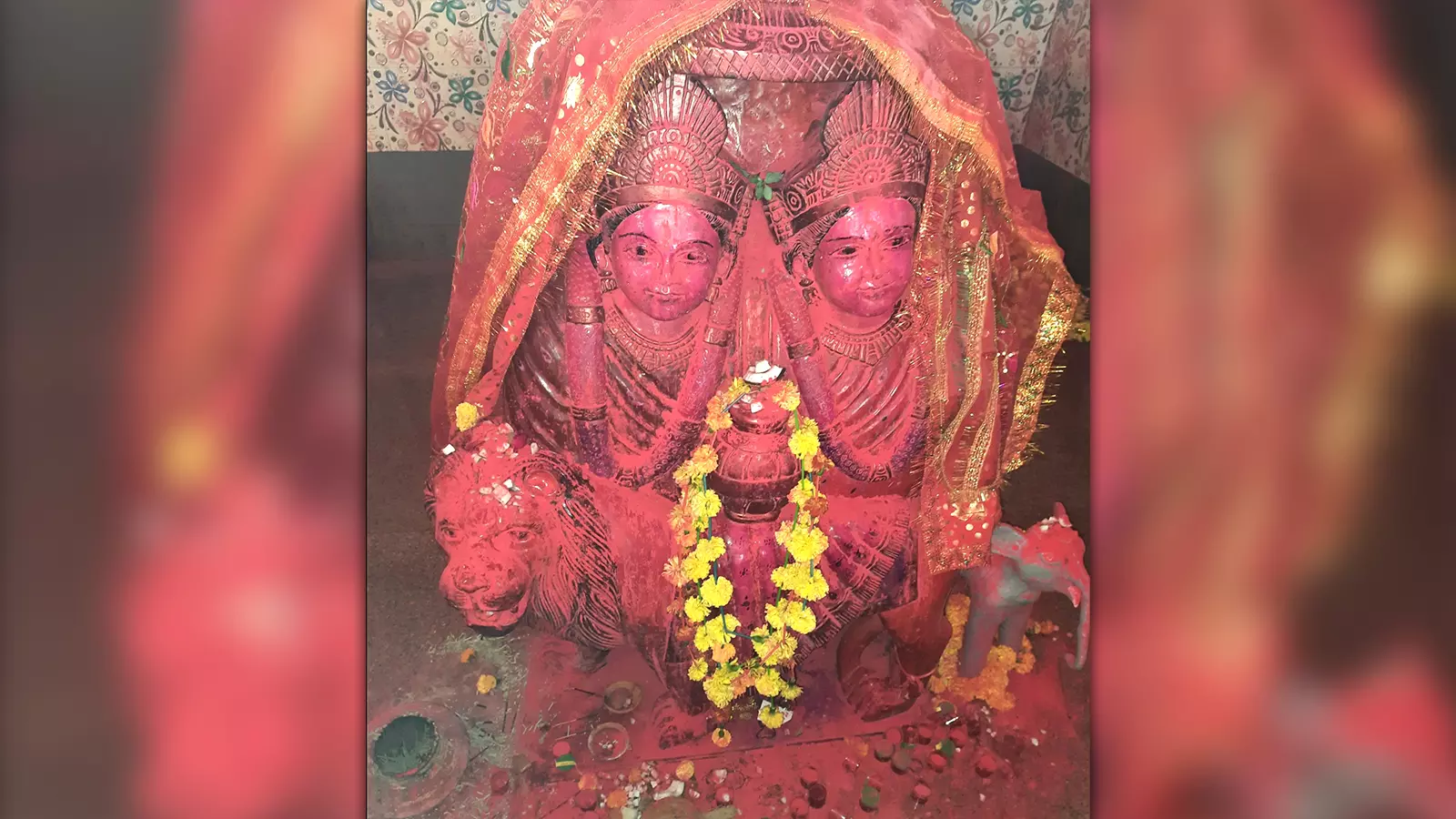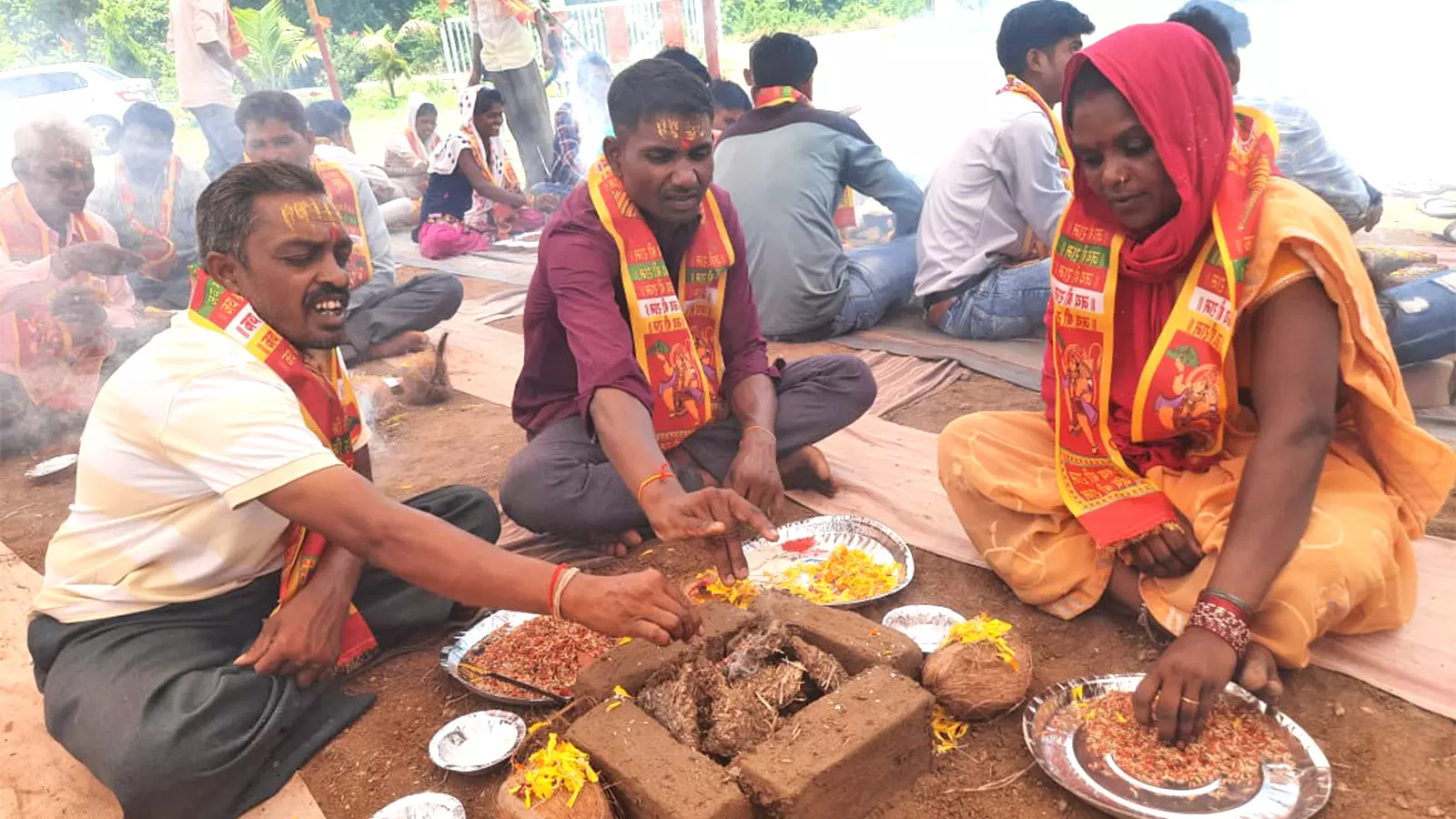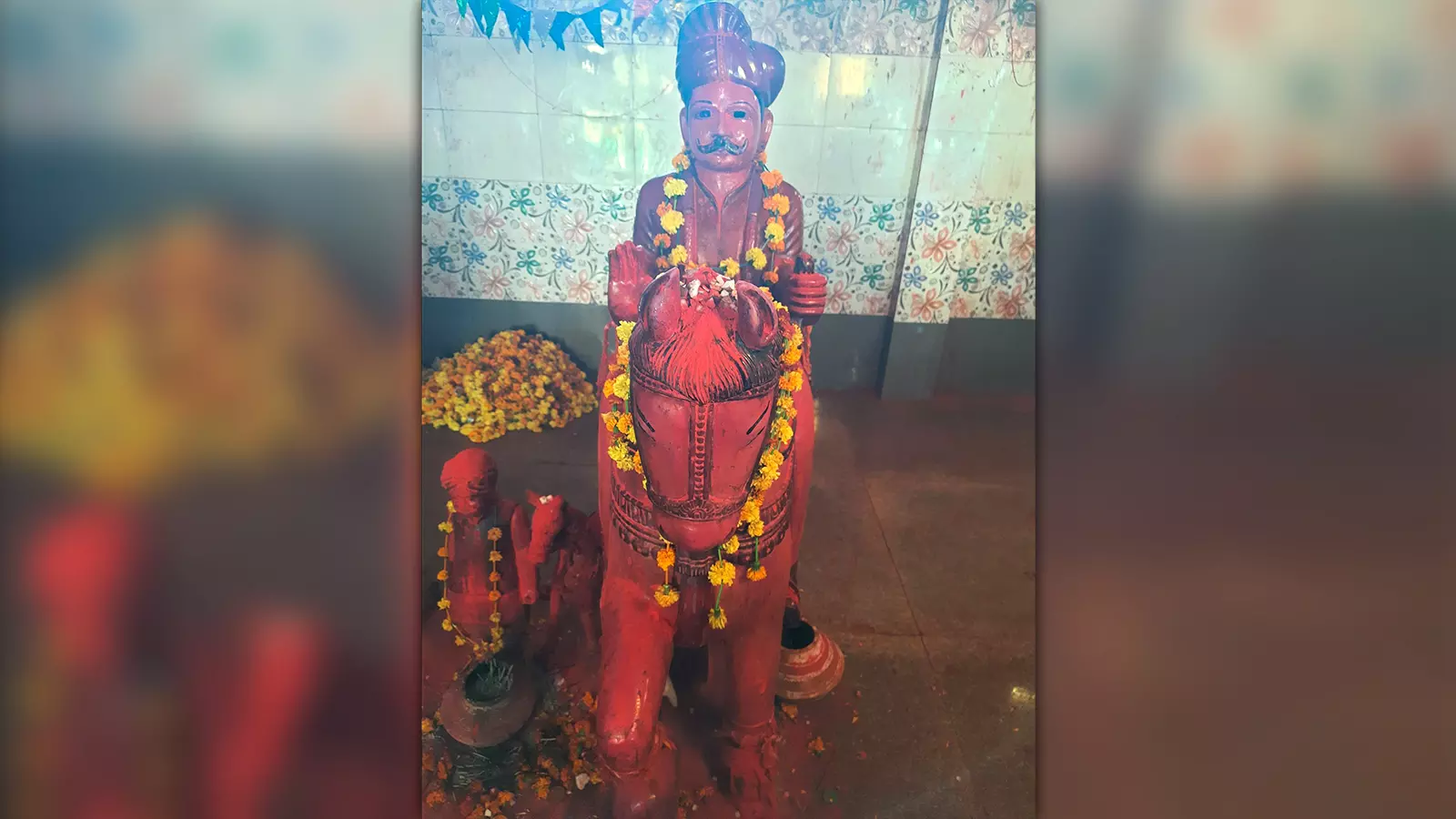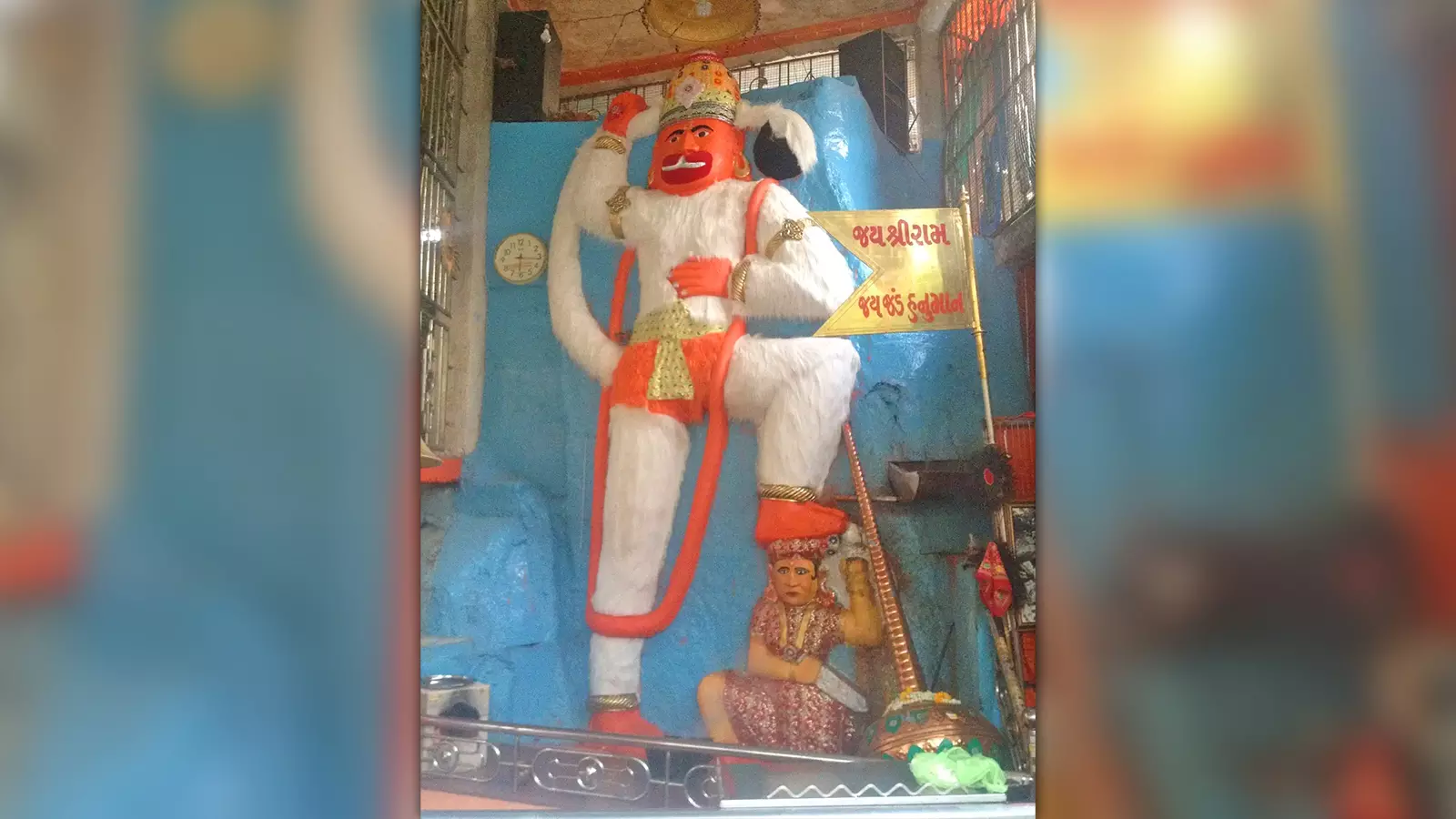
- Home
- India
- World
- Premium
- THE FEDERAL SPECIAL
- Analysis
- States
- Perspective
- Videos
- Sports
- Education
- Entertainment
- Elections
- Features
- Health
- Business
- Series
- In memoriam: Sheikh Mujibur Rahman
- Bishnoi's Men
- NEET TANGLE
- Economy Series
- Earth Day
- Kashmir’s Frozen Turbulence
- India@75
- The legend of Ramjanmabhoomi
- Liberalisation@30
- How to tame a dragon
- Celebrating biodiversity
- Farm Matters
- 50 days of solitude
- Bringing Migrants Home
- Budget 2020
- Jharkhand Votes
- The Federal Investigates
- The Federal Impact
- Vanishing Sand
- Gandhi @ 150
- Andhra Today
- Field report
- Operation Gulmarg
- Pandemic @1 Mn in India
- The Federal Year-End
- The Zero Year
- Science
- Brand studio
- Newsletter
- Elections 2024
- Events
How Hindu gods replaced tribal prayer practices in Gujarat

As one traverses past Ankleshwar in Bharuch, an area known for the Gujarat Industrial Development Corporation (GIDC), into the tribal belt of Gujarat, the condition of the roads worsen. Past Ankleshwar, mud cottages replace cement houses and small tea stalls replace branded eateries. It is as difficult to miss this change as it is to not notice the multiple small temples along the hillocks...
As one traverses past Ankleshwar in Bharuch, an area known for the Gujarat Industrial Development Corporation (GIDC), into the tribal belt of Gujarat, the condition of the roads worsen. Past Ankleshwar, mud cottages replace cement houses and small tea stalls replace branded eateries. It is as difficult to miss this change as it is to not notice the multiple small temples along the hillocks in Jhagadia. Almost all are dedicated to the Hindu deity Hanuman.
“These temples did not exist a few years ago. They have just come up and we don’t know who built them,” says Naresh Baria, a resident of Valia village in Jhagadia.
“My father tells me there used to be this spot near our house under the banyan tree where we used to place a stone in memory of our dead kins,” Baria says pointing towards the tree where an iron fence was converted into a Hanuman temple last year.
“No idol has been installed yet but the villagers have been worshipping our ancestral stones daily with tilak and flowers,” he says.
Baria, a daily wage earner, is one of the many tribal youths in his village who have migrated to either Surat or Ankleshwar in search of livelihood.
“There is no employment here. We grow some vegetables in our backyard and buy or exchange some vegetables for rice from the haat (a local weekly market). But our family is growing and food is not enough for us. Besides, I need to earn to send my two children to school,” says Baria, a tribal in his late 40s belonging to the Kunbi community.

The idol of a tribal king replaced with Lord Ram and Sita.
“Kunbis and Bhils (another tribal community) are nature-worshippers and did not originally worship idols. Today, it is not uncommon to see Ram Katha and families worshipping Hanuman in our village,” says, 82-year-old Chandan Baria, father of Naresh.
“Our culture has been very different from practices of Hinduism. For instance, when Hindus worship Maa Durga and celebrate Navratri in the state, it is a time of mourning for us. Bhils and Kunbis mourn the fall of their king Asura who was tricked by Goddess Durga using her beauty and charm. The tribal tradition is to perform Dasai Naach, where men dance in villages dressed as women, in search of their lost king after seven days of mourning period. But for some years now, tribal kids have been attending garbas and celebrating Navratri. Except a few elders, who still follow the mourning rituals, villagers either pray in church or temple. For the last two years, the Dasai Naach has not been organised in our village,” he adds.
Infusing Hinduism
Noticeably, the tribals form about 15 percent of the electoral population of Gujarat, yet the tribal belt extending from Dang in South Gujarat to Sabarkantha in Central Gujarat has barely seen any development.
As an electoral population, the tribal belt had been a weak zone for the BJP and a traditional stronghold for the Congress in Gujarat. However, in the assembly polls of 2022, the BJP bagged 23 out of 27 seats in the tribal belt. The Congress was completely ousted with two seats while the new entrant Aam Aadmi Party won two seats.
“BJP’s outreach programmes have paid off finally,” Ashutosh Desai, a diamond trader based in Surat and a veteran RSS member, tells The Federal.
“Tribals are worshipers of nature. They worship their ancestors by laying a stone in their memory. These stones are being painted saffron and temples are being built around these stones. That apart, there has been a sudden rise in visits by Hindu godmen and in events like Ram Katha in the last few years. This is one of their many ways to infuse Hinduism into tribal practices and culture,” Romel Sutariya, a tribal rights activist and political analyst tells The Federal.
“The tribals of Gujarat are usually caught between Christian missionaries and right wing outfits, each trying to convert the tribals into their belief system. In fact, a systematic process of political infiltration camouflaged in cultural influence has been carried out by the Rashtriya Swayamsevak Sangh (RSS) and other right wing affiliated organisations since the late 1990s. There was a time when tribal regions like Dang witnessed multiple communal riots targeting the tribal Christians and churches in the area,” says Sutariya, who works in the Tapi district of south Gujarat, a region dominated by tribals.

A tribal man converting to Hinduism.
“However, religion has never been a bone of contention amongst tribals. Locals here are no stranger to multiple religious identities. But they always prefer to follow their own cultural practices over religious ones,” he adds.
Tribal identity: a tug of war
Debku Vasava, a 68-year-old resident of Chinchod village in Dang, lives in a mud and brick house that he built himself. Vasava’s two brothers also live in the same house. The Vasavas belong to the Kunbi community but follow different religions.
Debku converted to Christianity seven years ago.
“Religion has never been a point of contention in our family,” says Debku Vasava. His younger brothers have been practicing Hinduism for two years now.
“On Christmas last year, we decorated the church with my brothers and their families as well. My brother’s daughters made flower garlands and buntings,” says Debku.
In the tribal hamlet of Chinchod, a village with a population of about 600, the tribals depend primarily on agriculture along with the neighbouring bamboo forest for cooking wood and other food supplies.
The village is around 150 kilometres from Surat, its nearest city. There is no mobile connectivity, concrete roads or primary health centre. The tribals here are mostly isolated from the politics of the state. Barring poll campaigns, no one ever visits the village. Locals, however, say the environment of the village has changed in the last few years.
“Earlier, we had a church with a thatched roof where tribal Christians families of the village prayed. Three years ago, they erected a small Hanuman temple in the village. People from Surat had come for the inauguration. Many youths joined them as they also promised jobs in city,” adds Debku.
“It was peaceful in the village. Nobody bothered about each other’s religion here. But since the temple has been built, news of communal flare-ups, even from elsewhere upsets the social harmony in the village. There have been fights between groups in the village,” Debku’s neighbour Raju Vasava says.

The original deity of tribal king.
A few kilometres from the church in Chinchod village is a private school run by Lalubhai Vasava, a Bhil tribal teacher and a social activist. Vasava has been demanding a separate religious code for tribal communities for over a decade.
“We are tribals… Adivasis. Not Hindu, not Christian,” says Lalubhai, who has been a social activist and teacher since 1992.
“Tribals have their own cultural identity, which has been passed off through generations as rituals and customs. Our culture is our religion,” says Vasava, who heads the Rashtriya Adivasi Dharm Samanvay Samiti, an organisation that works on educating tribal children in South Gujarat.
Vasava has written several books in Gujarati and Hindi on the need to preserve tribal history. The walls of his school are filled with murals of Sidho Kanu, Birsa Munda and other tribal leaders and icons.
Replacing gods with gods
“Both Hindus and Christians have tried to appropriate our histories, identity and our culture to win political battles. The Hindus want us to believe we are Hindus. They replace our Kuldevi (ancestral deity) with Ambe Mata (a female goddess) and our ancestral stone has been transformed into Lord Hanuman with red tilak. While Christians claim Jesus or reading the Bible will bring us salvation,” says Vasava asserting that real issues of the tribals goes unheard in the political noise.
“Hindutvisation of the tribal people began in the late 1980s in Gujarat, but it gained momentum in mid or late 1990s. During mid-to-late-1997, violence against Christian tribals was being routinely reported from Dang district. Local tribal activists claim that it was carried out mostly by the Hindu Jagran Manch, a sister organisation of the Vishwa Hindu Parishad (VHP),” says Indira Hirway, Gujarat-based author and historian.
“This process has divided the tribals. Rathwas, a tribal community that has been exposed to these socio-religious experiments the most, began to hail themselves as the Kshatriyas amongst the tribals. Between 2015 and 2016, the state government removed the Rathwas from the Scheduled Tribes (ST) quota list as Kshatriyas don’t ideally fall into the category. However, after a massive protest by the Rathwas, they had to be included back in the ST quota. Tribals, especially the Bhils led by the Bharatiya Tiger Sena, an outfit floated by tribal leader and seven-time MLA Chotubhai Vasava held massive protests,” she adds.
Noticeably, the demand for de-listing Christian Adivasis and other communities from the ST category has been raised many a times in Gujarat by groups such as the VHP and other sister organisations. Most of these groups work under the leadership of Swami Aseemanand who moved to Dang in 1995 and has since played an important role in initiating various programmes to convert tribals to Hinduism.
However, in 2010, Aseemanand was arrested on terror charges in the Samjhauta train blast case leaving his followers scattered and leaderless. However, he was acquitted in all these cases in 2017. Following his return to Dang, Aseemanand formed the Rashtriya Janjati Sang, an affiliate of the RSS and erected a temple at Dang dedicated to Shabri, a female goddess. He currently lives on the temple premises.
A mix of religion, politics and economy
In the 2012 Gujarat election, 16 of the 27 ST seats were won by the Congress. The BJP got 10 and one seat went to Chhotubhai Vasava who was then with the Janata Dal (United). It was almost a repeat in the 2017 state polls, when the Congress had won 16 seats, the BJP nine and the JD(U) one out of the total 26 ST seats back then.
However, ahead of the 2022 polls, the BJP workers in the tribal areas seemed confident of getting more seats.
“We never deny that earlier the BJP was not in a good shape in the tribal areas but following a series of welfare programmes of both state and union government, we have fared well in the tribal belt,” says Bharat Pandya, BJP in-charge of tribal districts.
That, however, is not the only reason for the BJP’s massive win in the tribal belt in 2022.
“Rashtriya Swayamsevak Sangh, and its cultural affiliates have accelerated their ground work in the tribal belt since late 2020,” said Kulin Pradhan, who oversees the RSS’ work at Vyara in Tapi district.
“Pracharaks and swayamsevaks have been visiting tribal villages. The Vishwa Hindu Parishad and Dharma Jagaran Vibhag of the RSS have also been very active in the tribal areas,” he says, adding that the mandate to speed up activities in the tribal belt came way back in 2016.
“The number of Ekal Vidyalayas (schools run by the VHP) in Adivasi villages, has almost doubled since December 2016. In Tapi district, for instance, the number of Ekal Vidyalayas has grown from 300 in 2016 to more than 1,000 now. We also have been extensively organising Harikatha (a form of religious musical story telling discourse),” Pradhan said.
“The Tapi unit of RSS got tribals trained in Harikatha at places like Vrindavan and Ayodhya. Now, it is organised at least twice or thrice a month in every tribal block of Tapi. To unite Hindu society, we have also started large-scale distribution of idols of Hindu deities to tribal villagers,” he added.
Noticeably, the RSS runs at least a dozen trusts in the region and three cooperative societies which were set up to help the tribals financially. The cooperative societies even though not registered function like banks and offer loans and collect cash for small savings and investments from tribal communities.

A Hanuman temple in Jhagadia.
This apart, at least eight other organisations are run in the tribal belt by sister organisations to work among the tribals.
“We are trying to bring back the Christian tribal into the Hindu fold and it is not through religion but tough economy. We help the tribal villages build their own business, plan their finances and savings and promote entrepreneurship,” said Dilipsinh Chauhan, the RSS in-charge for village development for Dahod district.
“The largest cooperative society in Dahod is the Sri Ram Bank. It has 13,000 tribal members, a seven-member board that is headed by Chauhan as the managing director. A group of 28 agents collects deposits from families. The society offers four per cent interest for its schemes, agents earn a commission of two per cent,” says Chauhan, adding that though covered under state government regulations, these cooperatives function mostly autonomously.
